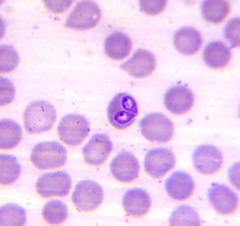Domain Eukaryota Scientific name Piroplasmida Rank Order | ||
 | ||
Lower classifications | ||
Piroplasms (order Piroplasmida) are eukaryotic parasites of the phylum Apicomplexa. They divide by binary fission and as sporozoan parasites they possess sexual and asexual phases (sexual reproduction occurs in the tick gut). They include the tick parasites Babesia and Theileria.
Description
They are minute rounded or pyriform parasites found within erythrocytes, or other circulating or endothelial cells of vertebrates, where they reproduce by merogony. The trophozoite stage is separated from erythrocyte by a single membrane. This distinguishes them from other blood parasites that usually have at least two membranes.
An apical complex with a polar ring and rhopteries occurs, but without a conoid and usually without associated pellicular microtubules. They lack flagella and do not form either oocysts or spores.
The known vectors are ticks or leeches in which they undergo sporogony; sexual reproduction probably occurs in the vector.
